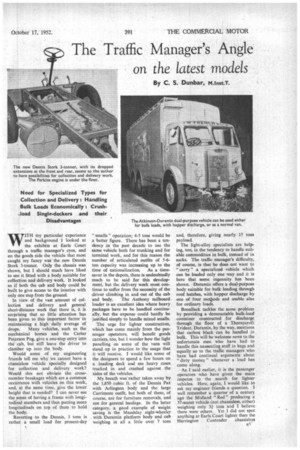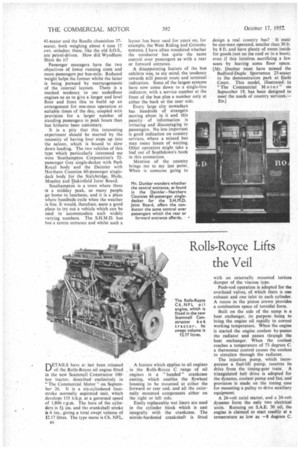The Traffic Manager's Angle
Page 39

Page 40

If you've noticed an error in this article please click here to report it so we can fix it.
on the latest models By C. S. Dunbar, M.Inst.T.
WITH my particular experience and background I looked at the exhibits at Earls Court through a traffic manager's eyes, and on the goods side the vehicle that most caught my fancy was the new Dennis Stork 3-tonner. Only the chassis was shown, but I should much have liked to see it fitted with a body suitable for collection and delivery work. It looked as if both the cab and body could be built to give access to the interior with only one step from the ground.
In view of the vast amount of collection and delivery and general short-distance work that there is, it is surprising that so little attention has been given to this important factor in maintaining a high daily average of drops. Many vehicles, such as the mechanical horses and the Carter Paterson Pug, give a one-step entry into the cab, but still leave the driver to clamber up into the body.
Would some of my engineering friends tell me why we cannot have a chassisless vehicle specially designed for collection and delivery work? Would this not obviate the crossmember breakages which are a common occurrence with vehicles on this work, and, at the same time, give the lower height that is needed? I can never see the sense of having a frame with longitudinal members and then putting more longitudinals on top -of them to hold the body.
Reverting to the Dennis, 3 tons is rather a small load for present-day 1 " smalls " operation; 4-5 tons would be a better figure. There has been a tendency in the past decade to use the same vehicle both for trunking and for terminal work, and for this reason the number of articulated outfits of 5-6ton capacity was increasing up to the
time of nationalization. As a timesaver in the depots, there is undoubtedly much to be said for this development, but the delivery work must continue to suffer from the necessity of the driver climbing in and out of the cab
and body. The Anthony tailboard loader is an excellent idea where heavy packages have to be handled continually, but the expense could hardly be justified simply to handle mixed smalls.
The urge for lighter construction, which has come mainly from the passenger operators, will benefit goods carriers, too, but I wonder how the light panelling on some of the vans will stand up in practice to the usage that it will receive. I would like some of the designers to spend a few hours on a loading deck and see heavy cases trucked in and crashed against the sides of the vehicles.
My breath was rather taken away by the 1,850 cubic ft. of the Dennis Pax with Arlington body and the large Carrirnore outfit, but both of these, of course, are for furniture removals, and not for general haulage. In the latter category, a good example of weight saving is the Maudslay eight-wheeler with Duramin platform body and cab weighing in all a little over 7 tons and, therefore, giving nearly 15 tons payload.
The light-alloy specialists are helping, too, in the tendency to handle suitable commodities in bulk, instead of in sacks. The traffic manager's difficulty, of course, is that he does not want to " carry " a specialized vehicle which can be loaded only one way and it is here that some ingenuity has been shown. Duramin offers a dual-purpose body suitable for bulk loading through roof hatches, with hopper discharge by one of four mettiods and usable also for ordinary loads.
Bonallack tackles the same problem by providing a demountable bulk-load container constructed for discharge through the floor of a Thomycroft Trident. Duramin, by the way, mentions that carbou black can be handled in bulk. This will be welcome news to the unfortunate men who have had to handle this nauseating stuff in bags and equally so to the traffic managers who have had continual arguments about "dirty money" whenever a load has come along.
As I said earlier, it is the passenger operators who have given the main impetus to the search for lighter vehicles. Here, again, I would like to ask my engineer friends a question. I well remember a quarter of a century ago the Midland "Red" producing a .37-seater vehicle (not chassisless, either) weighing only 31tons and I believe there were others. Yet I did not spot anything at Earls Court lighter than the Harrington Contender chassisless leS
41-seater and the Beadle chassisless 37seater, both weighing about 4 tons 17 cwt. unladen; these, like the old S.O.S., are petrol-driven, How did Wyndham Shire do it?
Passenger managers have the two objectives of lower funning costs and more passengers per bus-mile. Reduced weight helps the former whilst the latter is being pursued by rearrangements of the internal layouts. There is a marked tendency to use underfloor engines so as to give a longer and level floor and from this to build up an arrangement for one-man operation at suitable times of the day, coupled with provision for a larger number of standing passengers in peak hours than has hitherto been customary.
It is a pity that this interesting experiment should be marred by the necessity of having four steps up into the saloon, which is bound to slow down loading. The two vehicles of this type which particularly interested me were Southampton Corporation's 52passenger Guy single-decker with Park Royal body and the Daimler with Northern Counties 60-passenger singledeck body for the Stalybridge, Hyde, Mossley and Dukinfield Joint Board.
Southampton is a town where there • is a midday peak, as many people go home to luncheon, and it is a place where hundreds cycle when the weather is fine. It would, therefore, seem a good place to try out a vehicle which can be used to accommodate such widely varying numbers. The S.H.M.D. bus has a centre entrance and whilst such a layout has been used for years on, for example, the West Riding and Grimsby systems, I have often wondered whether the conductor has quite the same control over passengers as with a rear or forward entrance.
A disappointing feature of the bus exhibits was, to my mind, the tendency towards still poorer route and terminal indication. Some of the largest systems have now come down to a single-line indicator, with a service number at the front of the bus plus a number only at either the back or the near side.
Every large city nowadays has hundreds of strangers moving about in it and this paucity of information is irritating and discouraging to passengers. No less important is good indication on country services, where a missed bus may mean hours of waiting, Other operators might take a leaf out of Southdown's book in this connection.
Mention of the country brings me to my last point.. When is someone going to design a real country bus? It must be one-man operated, smaller than 30 ft. by 8 ft. and have plenty of room inside for goods (not on the roof or in a boot). even if this involves sacrificing a few scats by leaving some floor space. [Mr. Dunbar must have missed the Bedford-Duple Sportsman 25-seater in the demonstration park at Earls Court. This model, illustrated in "The Commercial Motor" on September 19, has been designed to
meet the needs of country services.—
ED.]




















































































